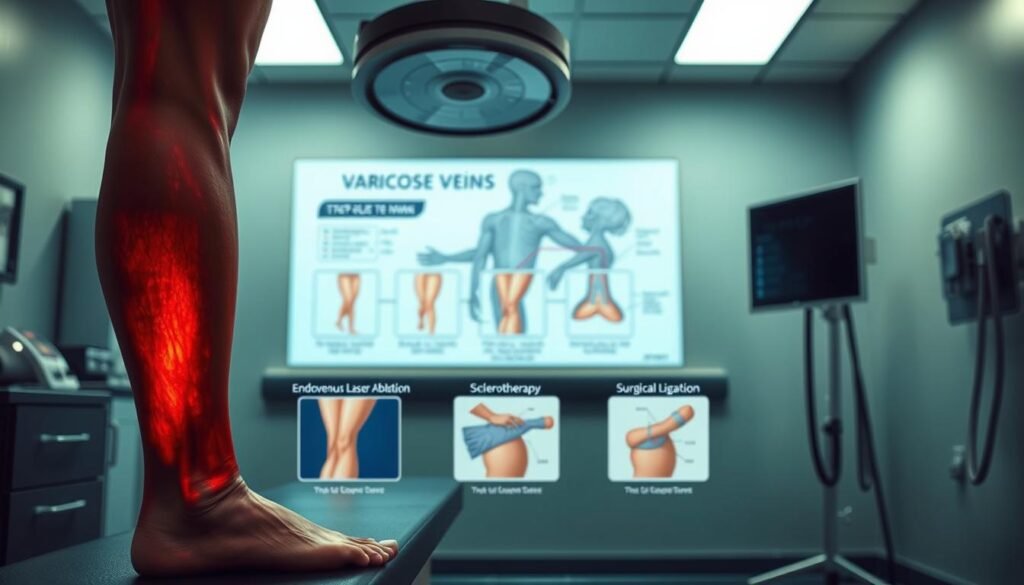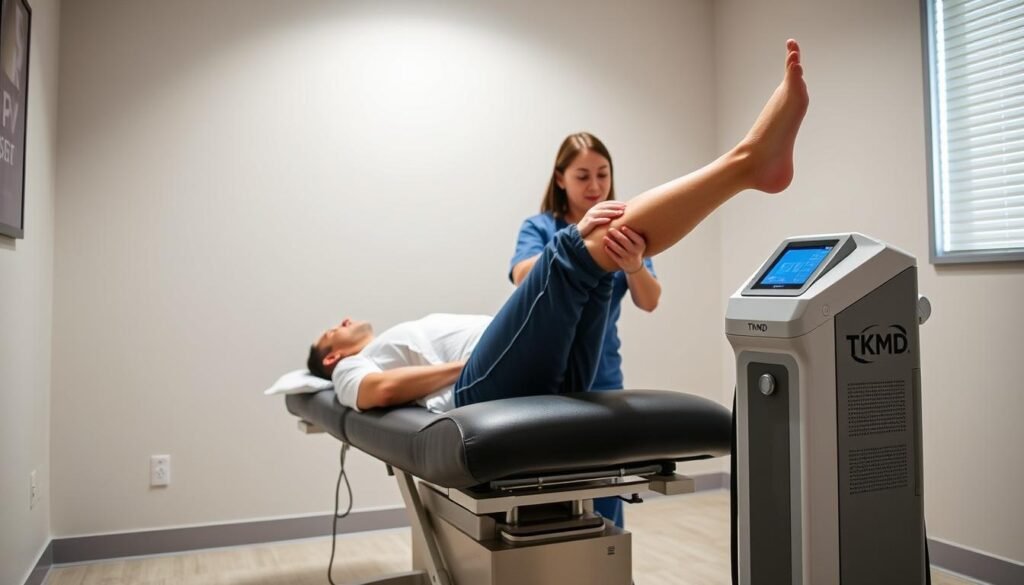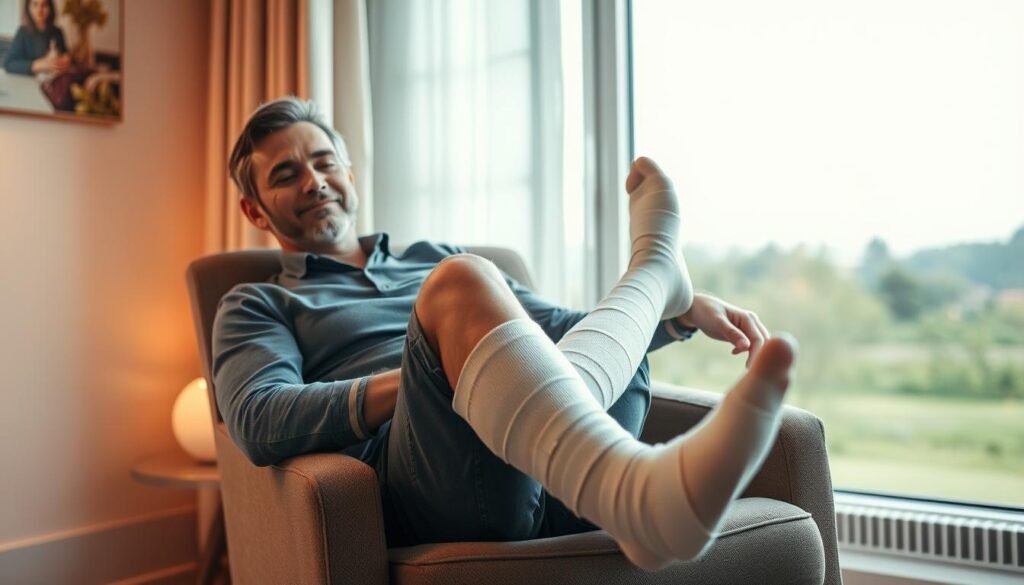Varicose veins can be a source of discomfort and self-consciousness for many individuals. These swollen, bulging veins often appear on the thighs or calves, causing pain and affecting one’s confidence. If you’re considering seeking relief, endovenous laser varicose vein surgery is a minimally invasive procedure that has gained popularity.
This procedure involves using heat from a laser to close and shrink the problematic vein, redirecting blood flow through healthier nearby veins. A consultation with a qualified healthcare provider is essential to determine if this treatment is right for you.
Key Takeaways
- Understand the procedure and what it entails.
- Learn about the technology behind endovenous laser treatment.
- Discover the benefits of this minimally invasive procedure.
- Find out what symptoms indicate you’re a candidate for this treatment.
- Understand the role of a healthcare provider in the procedure.
Understanding Endovenous Laser Treatment for Varicose Veins
For those suffering from varicose veins, endovenous laser treatment offers a minimally invasive solution. Varicose veins are a common condition where veins become enlarged and twisted, causing discomfort and pain.
What Are Varicose Veins?
Varicose veins occur when the valves within the veins fail, allowing blood to flow backwards and pool, leading to vein enlargement. This condition can cause symptoms such as leg pain, swelling, and visible varicose veins.
How Laser Treatment Works
Endovenous laser treatment involves using a laser to heat the affected vein, causing it to close off. This procedure is typically performed under local anesthesia and takes less than an hour to complete. The laser is inserted through a small incision, and the heat generated seals the vein shut.
Benefits of Choosing Laser Treatment
Compared to traditional varicose vein surgery, laser treatment is less invasive, resulting in less pain and a shorter recovery time. Most patients can resume normal activities within 24-48 hours. The procedure is usually completed in under 60 minutes.
| Benefits | Laser Treatment | Traditional Surgery |
|---|---|---|
| Invasiveness | Minimally invasive | Invasive |
| Recovery Time | 24-48 hours | Several weeks |
| Pain Level | Less pain | More pain |
When Laser Treatment Is Recommended
The decision to undergo laser treatment for varicose veins depends on several factors, including the severity of symptoms, the size and location of the affected veins, and the patient’s overall health.
Common Symptoms That May Require Treatment
Individuals experiencing symptoms such as leg pain, swelling, or visible varicose veins may benefit from laser treatment. These symptoms can significantly impact quality of life, and addressing them can improve overall well-being. Laser treatment is particularly effective for larger varicose veins that are close to the surface of the skin.
- Pain or discomfort in the legs
- Swelling or inflammation
- Visible varicose veins
Comparing Laser Treatment to Other Varicose Vein Procedures
When considering varicose vein treatment, it’s essential to compare the available procedures. Unlike traditional vein surgery or vein stripping, which involves removing the affected veins through multiple incisions, laser treatment is minimally invasive and has a shorter recovery time. Other options include sclerotherapy, radiofrequency ablation, and ambulatory phlebectomy, each with its own advantages and suitability depending on the patient’s condition.

Laser treatment stands out due to its effectiveness, shorter procedure time, and minimal scarring. The choice between surgery and laser treatment or other procedures depends on factors like vein size, location, and the patient’s health status.
Preparing for Your Laser Treatment
To ensure the best outcomes, patients must prepare properly for laser treatment. This involves several steps that help ensure the procedure is both safe and effective.
Medical Evaluation and Tests
Before the procedure, a medical evaluation is necessary to assess your overall health and the severity of your varicose veins. This may include ultrasound tests to visualize the veins and determine the best course of treatment. Your healthcare provider will use this information to tailor the procedure to your needs.
Medication Considerations
Certain medications may need to be adjusted or stopped before the procedure. It’s crucial to inform your healthcare provider about all medications you’re currently taking, including blood thinners, to avoid any complications during or after the procedure. Always follow your healthcare provider’s instructions regarding medication adjustments.
Day-of-Procedure Instructions
On the day of your procedure, wear loose, comfortable clothing and avoid applying lotions, oils, or creams to your legs. You’ll need to arrange for someone to drive you home after the procedure due to the effects of local anesthesia and possible sedation. Here’s a quick checklist for the day:
- Arrive at least 30 minutes before your scheduled appointment.
- Bring your insurance information, identification, and a list of your current medications.
- Wear clothing that allows easy access to the treatment area.
- Plan to spend about 2-3 hours at the facility.
By following these guidelines, you can help ensure a smooth and successful laser treatment procedure. 
| Preparation Step | Description |
|---|---|
| Medical Evaluation | Assess overall health and varicose vein severity |
| Medication Adjustment | Adjust or stop certain medications as advised |
| Day-of-Procedure | Wear loose clothing, arrange for a ride home |
The Laser Treatment for Varicose Veins Procedure
The endovenous laser treatment procedure is designed to be efficient, typically taking under an hour to complete. This modern approach to treating varicose veins involves a series of steps that are both straightforward and minimally invasive.
Step-by-Step Process
The procedure begins with the insertion of a catheter into the affected vein under ultrasound guidance. Once in place, a laser fiber is guided through the catheter and positioned at the top of the vein. Laser energy is then applied as the fiber is slowly pulled back, closing the vein. The entire process usually takes about 45-60 minutes per leg.
What You’ll Feel During Treatment
During the procedure, you might feel some sensations as the laser energy is applied, but local anesthesia is used to minimize discomfort. Some patients report a mild feeling of heat or tingling, but this is generally well-tolerated.
Duration and Immediate Post-Procedure Care
After the procedure, compression stockings are applied to aid in healing and reduce swelling. You will be encouraged to walk for about 30-60 minutes immediately after the treatment to promote blood flow. Your healthcare provider will give you specific instructions on post-procedure care, including how long to wear compression stockings, usually for the first 24-48 hours.
| Procedure Aspect | Description | Duration/Recovery |
|---|---|---|
| Procedure Time | Laser energy application | 45-60 minutes per leg |
| Post-Procedure Care | Compression stockings | 24-48 hours |
| Immediate Activity | Walking | 30-60 minutes |
Recovery and Aftercare
To ensure the best outcomes after laser treatment for varicose veins, it’s essential to follow a proper recovery and aftercare plan. This involves understanding what to expect in the first 48 hours, the subsequent two weeks, and knowing when to seek medical attention.
First 48 Hours After Treatment
Immediately after the procedure, you may be able to drive home and resume light activities. However, it’s recommended to avoid strenuous exercises and heavy lifting for a couple of days. You should be able to manage any discomfort with prescribed pain medications.
First Two Weeks of Recovery
During the first two weeks, you may experience some bruising, swelling, or numbness around the treated area. These symptoms typically resolve on their own. It’s crucial to follow your healthcare provider’s instructions regarding activity levels and wound care.
When to Call Your Healthcare Provider
Monitor your condition closely and contact your healthcare provider if you notice signs of infection, such as redness, warmth, or fluid leaking from the incision site. Severe pain not relieved by medication, significant swelling, or difficulty walking are also reasons to seek immediate medical attention.
| Symptom | Action |
|---|---|
| Signs of infection (redness, warmth, fluid leaking) | Contact healthcare provider immediately |
| Severe pain not relieved by medication | Seek immediate medical attention |
| Significant swelling or numbness | Contact healthcare provider |

Potential Risks and Side Effects
Understanding the potential risks and side effects of laser treatment for varicose veins is essential for making an informed decision. While the procedure is generally considered safe, there are possible complications that can arise, some of which are serious.
Common Side Effects
Most patients undergoing laser treatment for varicose veins experience minimal side effects. However, some common side effects may include temporary bruising, swelling, or redness around the treated area. These effects are typically mild and resolve on their own within a few days. In some cases, patients may experience hyperpigmentation, or darkening of the skin along the treated vein, which can persist for several months or, in rare instances, become permanent.
Serious Complications to Watch For
Although rare, serious complications can occur after laser treatment for varicose veins. These may include deep vein thrombosis (DVT), a condition characterized by pain, swelling, warmth, and redness in the leg, which requires immediate medical attention. Other serious complications can include pulmonary embolism, a potentially life-threatening condition that occurs if a blood clot breaks loose and travels to the lungs, causing symptoms such as chest pain, shortness of breath, and rapid heart rate. Additionally, there is a risk of infection at the incision site, arterial damage if the laser inadvertently affects a nearby artery, and nerve injury resulting in persistent numbness, tingling, or pain. It’s crucial to discuss these potential complications with your healthcare provider before the procedure and to follow their instructions for post-procedure care to minimize risks and achieve the best results.
It’s also important to note that, in rare instances, the treated vein may reopen, requiring additional treatment. Your healthcare provider should provide clear guidance on what to expect during recovery and when to seek medical attention if complications arise.
Conclusion: Is Laser Treatment Right for You?
Endovenous laser treatment has emerged as a highly effective solution for varicose veins, offering a minimally invasive alternative to traditional surgery. This procedure is particularly beneficial for individuals with medium to large varicose veins that cause symptoms such as pain, swelling, or skin changes. Most patients experience significant improvement in both the appearance of their legs and relief from symptoms within 2-3 weeks after treatment.
It’s crucial to consult with a qualified healthcare provider to determine if laser treatment is the right approach for your specific condition. While the treated veins will be permanently closed, new varicose veins may develop over time. Maintaining a healthy lifestyle, including regular exercise and weight management, can help prevent new veins from forming. With its high success rates, minimal discomfort, and quick recovery, endovenous laser treatment is an attractive option for many patients.


